Introduction

Pickles, a staple in many cuisines worldwide, offer a tangy, refreshing burst of flavor that complements a wide array of dishes. Whether enjoyed as a side, a topping, or an ingredient in more complex recipes, pickles are cherished for their unique taste and texture. Among the myriad qualities that make pickles appealing, crispiness stands out as a defining characteristic that many enthusiasts strive to achieve. This article delves into the intricacies of how to make pickles crisp, exploring various techniques, ingredients, and considerations that contribute to achieving the perfect crunch.
Understanding Pickle Crispiness
Before diving into the methods for enhancing pickle crispiness, it’s essential to understand what gives pickles their crunch. The crispness of pickles is primarily attributed to their cellular structure, which remains intact when properly preserved. When vegetables like cucumbers (commonly used for pickles) are submerged in a brine solution, the cells can either retain their structure or break down, leading to softer pickles. Maintaining cell integrity involves several factors, including the type and freshness of the vegetable, the brine composition, processing techniques, and storage conditions.
Choosing the Right Vegetables
The foundation of crispy pickles begins with selecting high-quality, fresh vegetables. Here are some key considerations:
-
Variety: Different varieties of cucumbers and other vegetables have varying levels of firmness. For instance, pickling cucumbers are specifically bred for their ability to retain crispiness during fermentation or brining.
-
Freshness: Fresh vegetables have stronger cell walls, which are crucial for maintaining crispness. Avoid vegetables that are overripe, bruised, or have soft spots.
-
Size and Shape: Smaller, more uniform vegetables tend to pickle more evenly, ensuring consistent crispiness throughout.
-
Handling: Gentle handling during harvesting and preparation minimizes damage to the vegetable’s cells, preserving their structure.
Preparing the Vegetables
Once you’ve selected the perfect vegetables, proper preparation is essential to retain their crispiness:

-
Washing: Thoroughly wash vegetables to remove dirt and debris but avoid soaking them, which can soften the exterior.
-
Trimming: Remove ends and any blemishes, but keep as much of the vegetable intact as possible to preserve its natural structure.
-
Coring and Seeding: For larger vegetables like cucumbers, coring and seeding can reduce soft spots and improve the overall texture.
-
Salting: A brief saltwater soak or sprinkling with salt can draw out excess moisture, firming up the vegetable’s flesh. Rinse and dry thoroughly before pickling.
Brine Composition and Preparation
The brine is the pickling liquid that preserves the vegetables and gives them flavor. Its composition plays a crucial role in maintaining crispiness:
-
Salt Concentration: The right balance of salt is essential. Too little salt can lead to bacterial growth and softening, while too much can inhibit fermentation and make the pickles inedible. A typical brine for fermented pickles contains about 2-3% salt by weight of the water.
-
Acidity: Vinegar or lactic acid from fermentation helps preserve the pickles and contributes to their flavor. The acidity level also affects crispiness. Higher acidity can soften vegetables, so finding the right balance is key.
-
Water Quality: Use clean, filtered water to avoid contaminants that can affect texture and flavor.
-
Flavorings: Herbs, spices, and other flavorings can be added to the brine, but they should not interfere with the pickling process or crispiness.
Pickling Techniques

There are several methods for pickling vegetables, each with its own impact on crispiness:
-
Fermented Pickles: This traditional method uses naturally occurring bacteria to ferment the vegetables, creating lactic acid. It requires precise temperature control and monitoring to avoid over-fermentation, which can soften the pickles.
- Temperature: Keep the fermentation vessel at a consistent temperature, typically between 68-75°F (20-24°C).
- Air Exposure: Minimize exposure to air during fermentation to prevent mold and off-flavors.
- Weighting Down: Use a weight to keep the vegetables submerged in the brine, ensuring even fermentation.
-
Quick Pickles: These are made by immersing vegetables in a vinegar-based brine and refrigerating them immediately. Quick pickling preserves crispiness by bypassing the fermentation process.
- Brine Temperature: Use cold brine and refrigerate the pickles immediately after packing to slow down any softening.
- Storage: Keep quick pickles in an airtight container in the refrigerator to maintain crispiness and freshness.
-
Refrigerator Pickles: Similar to quick pickles, refrigerator pickles use a vinegar-based brine but may include additional sugars or spices. They rely on cold temperatures to slow down spoilage and maintain crispiness.
- Ingredients: Adjust the sugar and vinegar ratio to taste, but remember that higher acidity can soften the vegetables.
- Storage Time: Consume refrigerator pickles within a few weeks to maintain optimal crispiness and flavor.
-
Canning Pickles: While canning preserves pickles for longer periods, it often involves higher heat processing, which can soften the vegetables. To retain some crispiness:
- Processing Time: Use the shortest processing time possible for the desired safety level.
- Packaging: Pack the pickles tightly in jars to minimize movement during processing, which can cause damage.
Storage and Handling
Proper storage and handling are vital to maintaining the crispiness of pickles after they’ve been made:
-
Temperature: Store pickles in a cool, dark place. For refrigerator pickles and fermented pickles, this means the refrigerator.
-
Container: Use glass jars with tight-fitting lids to prevent air exposure and contamination.
-
Opening and Closing: When opening a jar of pickles, be careful not to introduce contaminants. Seal the jar tightly after each use.
-
Consumption: Eat pickles within their recommended storage period to ensure optimal crispiness and flavor.

Troubleshooting Common Issues
Even with the best intentions and techniques, issues can arise that affect pickle crispiness. Here are some troubleshooting tips:
-
Soft Pickles: This can be caused by over-fermentation, too high acidity, or improper storage. Check your brine composition, fermentation conditions, and storage practices.
-
Slippery Texture: This often occurs due to excessive pectin release during processing. Adding calcium chloride to the brine can help firm up the texture.
-
Off-Flavors: These can be due to contamination, improper fermentation, or too long storage. Ensure cleanliness, monitor fermentation closely, and consume within the recommended timeframe.
Conclusion
Achieving crispy pickles is a blend of science and art, requiring careful selection of ingredients, precise preparation techniques, and diligent storage practices. By understanding the factors that contribute to crispiness and applying the appropriate methods, you can create pickles that are not only delicious but also perfectly crunchy. Whether you prefer the tangy tang of fermented pickles, the quick satisfaction of refrigerator pickles, or the long-lasting preservation of canned pickles, with the right techniques, you can enjoy the perfect crunch in every bite. Happy pickling!





0 comments